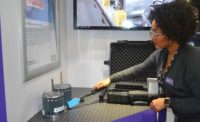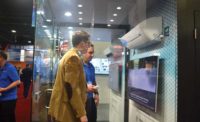TROY, Mich. — Building owners, managers, and engineers recently came together to learn about Armstrong Fluid Technology’s energy-efficient Design Envelope technology during an event held at Michigan Air Products’ Troy, Michigan, location. The event is one of 16 planned Design Envelope Symposiums the manufacturer has scheduled around the U.S. this year.
“We’re always trying to promote innovative, energy-efficient solutions that can be used in today’s construction environment,” said Paul Joliat, president, Michigan Air Products. “Today’s Design Envelope concept is somewhat earthshattering in terms of potential energy savings over traditional pump selections. We are always promoting these technologies to consulting engineers. At today’s symposium, we have people from all walks of life, including building owners, building managers, consulting engineers, maintenance engineers, and more. The technology is applicable across a variety of markets. We just want to get the word out about these newer technologies that exceed ASHRAE 90.1, which is the benchmark everybody’s trying to meet today.”
TECHNOLOGICAL INTRODUCTIONS
Armstrong’s Design Envelope Symposium began as more of a grassroots effort, according to Matt Berrell, national sales manager, USA, commercial design build, Armstrong Fluid Technology. “The idea was, ‘Let’s take Design Envelope out to the masses,’” he said. “It’s been around for a long time — in the U.S. for almost seven years — and we’ve kind of gone through some different marketing phases. We decided to get in front of our customers and bring our subject matter experts into the foreground and let them teach.”
The manufacturer held 10 events in the U.S. and Canada last year. They were so successful that Armstrong expanded its scope in 2015 to include international locations such as Mumbai, India; and Dubai, United Arab Emirates. Armstrong has a total of 55 Design Envelope Symposiums scheduled this year.
“As we started to do the rallies last year, we noticed we had a real uptick in activity in those areas,” Berrell noted.
The event offers professional development hours toward accreditation, which helps entice skilled workers from a number of trades, said Andrei Hari, commercial business development manager, Armstrong Fluid Technology.
Armstrong’s Design Envelope IVS pumps reduce pumping costs through variable-speed, demand-based operation, consuming only the energy required based on current system demand. Design Envelope IVS pumps use a combination of optimized impeller size and speed control for energy-efficient operation within a given performance envelope. The performance envelopes are mapped for the best pump efficiency at 50 percent of the design flow rate, where variable flow systems operate most often. This ensures a building’s hydronic pumping system consumes as little energy as possible and that the installation meets ASHRAE 90.1 guidelines requiring 70 percent energy savings at 50 percent of peak load.
The increased range of operating performance in design envelope variable-speed technology also reduces the risk of underperformance in HVAC systems. As occupant load or building surroundings change, building loads change, as well. An Armstrong Design Envelope pump operates at high efficiency levels that provide the exact pumping performance necessary to keep HVAC system costs at a minimum. The system provides building owners adaptability to changes that can occur during a building’s operating life.
“There are multiple benefits to Design Envelope technology,” Berrell said. “These fully integrated pumps come with an integrated pump controller mounted on our vertical inline pump. They’re all fully factory-tested. The pump is ready to go as soon as it arrives on-site.
“You’re taking a lot of items that you would normally do in the field, and you’re transferring them to a controlled environment in the factory where there’s somebody who sits at a test stand and actually programs all these pumps,” he said.
That’s the first part of it, but, really, the core of it is the energy efficiency,” he continued. “By using our control curves and the technology at the factory, we actually get better energy savings at part-load performance. So, the Design Envelope is really focused on our part-load efficiencies rather than our full-load efficiencies. We get our savings and we achieve ASHRAE 90.1 2010’s goals of 70 percent savings at 50 percent flow.”
Berrell said people want the information on Design Envelope technology. “People want the information — they want to understand what we’re trying to do,” he noted. “It’s a good product, and I think they need to have a better understanding of it. When we get in front of them and actually bring our subject matter experts to the fore and let them teach, we’ve found that people get a better understanding of the technology. This helps establish a much broader acceptance of what we’re trying to do.”
For more information on Design Envelope Symposium locations, visit www.armstrongfluidtechnology.com.
Publication date: 6/29/2015
Want more HVAC industry news and information? Join The NEWS on Facebook, Twitter, and LinkedIn today!














